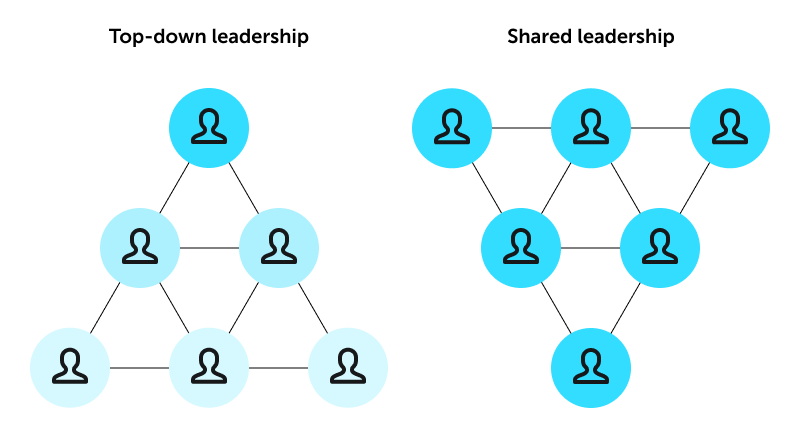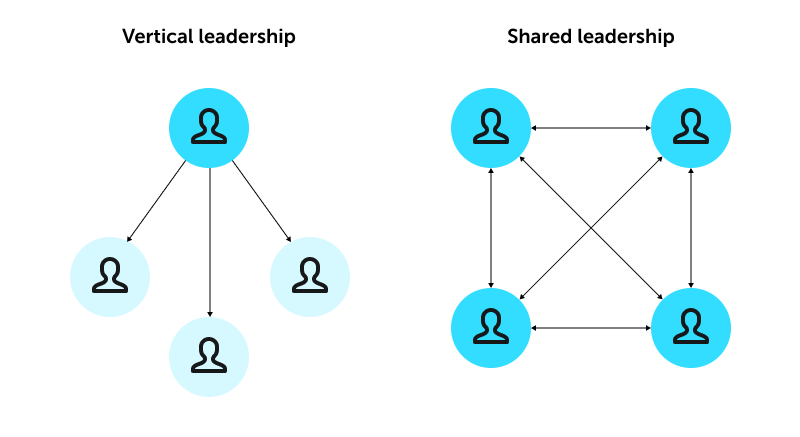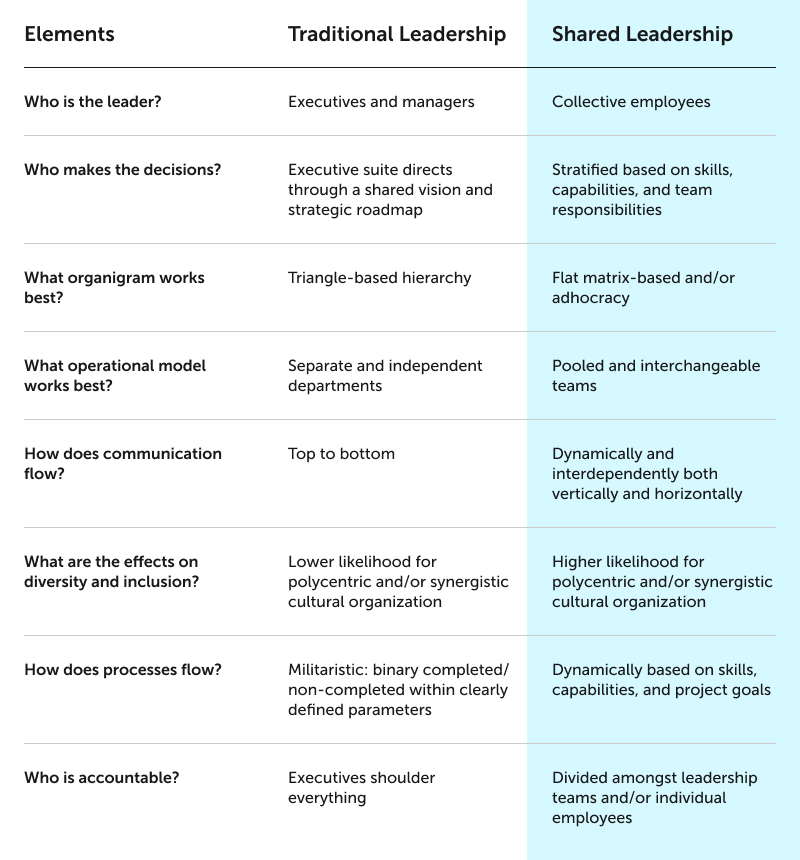Shared Leadership
Learn what is shared leadership and its pros and cons. Discover the difference between traditional leadership and tips on how to apply it in an organization.

Most organizations still favor a traditional leadership model over a shared leadership style, and this can lead to a decrease in performance and productivity.
A growing body of research suggests that shared leadership can be highly effective in certain situations but crucially, only if it has been planned and implemented.
In this piece, we will discuss:
- What is shared leadership
- Examples of shared leadership
- Traditional leadership vs. shared leadership
- Benefits of shared leadership
- Challenges of shared leadership
- How can you apply shared leadership in an organizational context?
What Is shared leadership?
Shared leadership is when each employee within an organization takes ownership and responsibility for the part they play. In effect, shared leadership enables each employee to shoulder their work without the oversight from a command-and-control style manager.

It is a horizontal leadership model, where teams and employees make up the collective direction of the organization, as opposed to the traditional triangle model where vision and direction are dictated by an executive suite.
However, a critical aspect of shared leadership is that it is a gradient. This means shared leadership can take many forms and iterations. Here are two different examples that can both as ‘shared leadership.’
Read: Leadership and Executive onboarding: 5-step plan
Example 1: No CEO
Solodev, a SAAS organization, initially decided to hire a CEO but found their company culture did not respond well to this. Instead, the responsibilities and decisions of the CEO were transferred to an “Executive Committee” of experts from different departments.
Experts and their perspectives fed into the executive decisions and direction of the company. When decision-paralysis emerged, the founder Shawn Moore would step in.
“Your goal as an executive is to build a company that can run without you, right? […] That’s why it’s important to empower your teams to make these decisions instead of relying solely on you.” – Shawn Moore
Example 2: Voted Leadership
Looking for a compromise between a rigid hierarchical structure and agile shared leadership is the Chinese appliance manufacturer, Haier, with their operational model: Rendanheyi.
Haier found that a traditional top-down hierarchical approach came with the lack of agility, but still wanted the visionary cohesion that a traditional leadership model comes with. The results with the Rendanheyi model, Haier found, were improved communication and productivity.
Essentially, the Rendanheyi is devised on, amongst other facets, micro-enterprises acting as smaller autonomous units within a larger company structure. The operational and tactical leadership within each unit is voted on by employees each year, while the visionary leadership is directed by upper management.
Thus, the Rendanheyi operational model is both shared and traditional leadership combined.

L&D strategy framework
You will receive a list of questions along with a spreadsheet template to help you analyse your L&D strategy.
DOWNLOAD FRAMEWORKTraditional Leadership vs. Shared Leadership
Traditionally, leadership is hierarchical through a triangle makeup. One executive shoulders the responsibilities and accountabilities of the organization, which subordinates then carry out. Usually, such a leadership chain is further stratified into increasingly detailed responsibilities and accountabilities, i.e., top managers, middle managers, and employees.
Oppositely, shared leadership suffuses responsibilities and accountabilities out to every employee in the organization working in pooled and dynamic teams.
For example, rather than an executive branch being accountable for employees’ work: the individual employee manages their own work and time.

As one of the thought leaders within dynamic reteaming and shared leadership, Robert Keidel, described such work as a baseball team where each employee is pooled at their station, working, and led independently and interdependently towards a shared company vision.
The table below is a visualization that summarizes the main differences.

Benefits of Shared Leadership
1. Increased organizational performance
A meta-analysis found that shared leadership is 34% more effective than traditional leadership. The reason is that shared leadership structures itself around change and innovation, which is found to have a higher impact on team performance compared to traditional leadership styles.
Moreover, shared leadership increases team effectiveness based on the notion of increased trust between employees from the co-leading of themselves and each other.
2. Improved collaboration, transferring of knowledge, and innovative thinking
Shared leadership encourages trust and knowledge sharing between employees.
One research discovered that shared leadership was particularly helpful in building knowledge sharing in a virtual working environment, i.e., decentralized and digital teams. Moreover, knowledge sharing increases the collaboration within the organization, improving innovation, and employee development, commitment, and involvement.
3. Increased job satisfaction and employee motivation
The Journal of Social Psychology published that shared leadership leads to team cohesion, consensus, and overall satisfaction, based on the collaborative effects.
Essentially, shared leadership encourages a link between the individual employee and the collective identity of the organization and team. And the research shown when sufficient linkage is established, stronger motivation follows.
4. Natural leaders emerge, not hired
When an organization adopts a shared leadership approach, natural leaders emerge within teams. Logically, this follows that innately more capable leaders are formed because they are not selected but arisen.
While the relationship dynamics between the leader and worker also is empowered. The reason is that when leaders aren’t hired but formed dynamically, it improves team cohesion, interplay, and performance. Oppositely, this can also pose a risk if a natural leader doesn’t become clear.
Challenges of shared leadership
1. The fundamentals must be set in stone
Introducing and implementing a fundamental shift into any organization requires careful preparation and solid foundations.
- Thus, it requires appropriate supervision to ensure a smooth transition towards a shared leadership model, which naturally needs sufficient leadership within the organization: as ironic as this may seem.
- Further, effective communication and decision-making are pivotal to the organization – if this is inefficient, shared leadership will exacerbate these inefficiencies.
- Similarly, with any elaborate change, a clear strategy and planning process must be instigated. Aligning vision and operational planning ensures a successful implementation whilst avoiding unexpected complications.
- Changing to a shared leadership model does require substantial start-up capital and resources. The reason for this, as written in “Non Profit Quarterly,” is that the transition from traditional to shared leadership will result in temporary decision making and responsibility complexity, leading to indirect costs from loss of efficiency.
2. Senior employees may respond adversely to shared leadership
Instigating shared leadership means that existing management must transition from goal-directed control to relationship and conflict management. This can result in friction from those who may need to give up some authority and it can be a stopgap for shared leadership.
This scenario is often seen in family-led multigenerational companies, the study found that multi-generational businesses are resistant to relinquishing control and object to shared leadership.
3. Increased interpersonal conflicts, extended communication and decision-making chains
Whilst shared leadership will become more efficient and agile in the long term, in the short- and mid-term, it can increase employee conflict, extend decision chain, and disrupt the direction of a company.
4. Advantageous for the opportunists
Opportunist behavior is a disadvantage for any business, and an organizational environment with limited oversight means that such self-interested actions are easier to pull off.
Effectively, shared leadership could enable opportunistic employees and has the potential to damage the business as a whole.
5. Work-life balance and burnout
In shared leadership, removing the manager from the equation might harm work-life balance. Based on that, employees who have access to flexible work agreements have been found to not take advantage of them.
Therefore, this effect could mean that employees who are their own boss will prioritize work and increase the risk of burnout.
Work burnout and some work-life balance issues have been linked to unsupportive managers.
If a manager is both practically and emotionally supportive, organizations encounter less work-life conflict, generally improved physical and mental health, and higher employee motivation.

L&D strategy framework
You will receive a list of questions along with a spreadsheet template to help you analyse your L&D strategy.
DOWNLOAD FRAMEWORKHow can you apply shared leadership in an organizational context?
Here are some pointers on how to apply shared leadership successfully.
Conditions that promote and sustain shared leadership [preparation]
1. Existing culture of trust among team members
A work culture where people feel like they can openly voice their feelings, thoughts, ideas, opinions, and emotions without fear of judgment is important here. A positive work environment leads to an increase in employee wellbeing, reduces turnover, increases loyalty, and promotes better job performance.
The study found that developing an organizational culture where employees feel their input is respected and valued ushers a higher willingness for leadership sharing and general commitment to team-set leadership goals.
“In strong cultures, people find safety in relationships. Strong relationships are the foundation of high-performing teams. And all high-performing teams start with trust.” – Simon Sinek, a book “The Infinite Game”
Read more about work culture: How to create a positive work culture
2. Willingness of senior leadership for changes
Existing leaders and managers must be willing to promote shared responsibility, accountability, and trust in employees throughout the organization. And not only that but also to change from a command-and-control role to emotional management and conflict resolution. Essentially, leadership must change responsibilities from them to employees.
However, traditional leadership must still thread throughout the organization to avoid silos, as clarified in implementing shared leadership with Kanban from Kanbanize.
Such shared vision can be communicated and executed in multiple ways, although one effective method is centralizing a project board for autonomous teams and employees to take on dynamically. In this way, leaders can, through projects, guide the organization towards desired goals.
3. Ability and willingness to invest time to educate and plan
Before you begin to apply shared leadership in a team, it is worth ensuring that the executives are ready to provide additional resources.
The same goes for the willingness to invest time to implement shared leadership as a gradual execution. Practically, this means ensuring systems are in place to adopt a shared leadership model.
One area crucial to this adoption is educating on the positive aspects of shared leadership, providing guidelines, and setting a few rules the team must follow. This helps establish employee expectations, prevent miscommunication and misdirection, and let team members know how to communicate successfully.
Another way is to educate team is how to be good leaders and reskill employees rather than hire a new team member who has experiences in shared leadership.
4. Shared leadership will empower already high-performing teams
The research found differences in team effectiveness between traditional or shared leadership structures. They found that shared leadership correlates to team effectiveness and performance in already high-performing teams. Thus, shared leadership maximizes results out of well-oiled teams.
At the same time, traditional leadership leads to the most team effectiveness in low-performing teams. In a sense, such groups require a firm guiding hand.
Furthermore, it was found that more complex work results in more significant positive effects from shared leadership. So shared leadership can be utilized to transcend already high-performing teams that equally undergo complex work combined with the proper leadership behaviour of transformational and empowering, backing it up.
5. Shared leadership benefits complex work
You should consider what type of work the team will be engaged in before applying shared leadership.
The previously referenced meta-analysis discovered that its positive effects align with the work’s complexity, which means that complex work, such as Research & Development, benefits more from shared leadership.
In contrast, standardized tasks, i.e., salary payments, do not benefit as clearly from shared leadership and are recommended to adopt a traditional leadership style.
Put shared leadership into action [steps and tips]
1. Provide a safe environment
A safe working environment is central to shared leadership. It means employees feel safe to propose innovative ideas that transform and effectively grow the businesses: ‘feeling safe to fail’. It also empowers employees to locate inconsistencies and inefficiencies in their work and others continually and not be afraid of judgements.
Tip 1. This goes back to establishing a support system for workers when their responsibility and accountability increase while instigating a positive culture guiding employees rather than minutely micromanaging them.
Tip 2. This further focuses on talent improvement and management, and a collective strive for mutual rather than individual growth.
Tip 3. Engage with employees on a personal and professional level. For example, learn their kids’ or pets’ names and celebrate their birthdays while also helping them achieve the goals that they set for the future.
You might be interested: How to improve emotional intelligence at the workplace
2. Encourage transparency
Linking back to the reflections and impetus on trust within the organization, then it essentially is about transparency and easily accessible information about the company’s situation, goals, and perspective throughout. In fact, eye-opening research by TinyPulse discovered that transparency has a 93% link with employee happiness connected with shared leadership.
Tip 1. Hire people who respect transparency. Think about it: if you hire employees who don’t understand or care about what it means to be open at work, you can’t expect them to meet your standards
Tip 2. Provide avenues for communication. Make sure your team members have proper places for communication with one another, whether it’s email or a chat software like Slack. Moreover, you may have online hub specifically for the employees to access information such as benefits, brand statements, employee discounts, organizational charts and more.
3. Create a clear structure
Shared leadership only functions well under certain complex circumstances. Effectively, this means that standardized tasks such as paying salaries or firing are best managed by traditional leadership styles. So, the organization must have clearly defined structures in place for when shared and traditional leadership is utilized.
Tip 1. organization can dynamically shift in leadership styles based on the complexity of the situation it is facing. Although this model requires significant adaptability, it is recommended mostly for smaller teams or start-ups to adopt this interchangeable mode of leadership.
Tip 2. To communicate the structures of shared leadership within the organization is to adopt a visualization of the dynamically changing communication patterns between employees. In practice, this can be a centralized back-end hub where employees can see a decision and responsibility map.
4. Restructure decision making and empower leadership behaviors
Another way to empower leadership behavior in employees is to design the organization through a dynamic reteaming model. Such mode is based on a project-led organization where employees interchangeably choose the projects, they desire to work on proposed by top management. Effectively, it encourages employees to adopt responsibility and accountability when no clear manager is attached. Instead, the natural formation of leaders will emerge from the dynamics within the team.
Tip 1. To cultivate a culture of leadership throughout an organization create leadership development plan. It helps to improve leadership skills and competencies through various activities for staff at all levels.
Tip 2. It is crucial to encourage big picture and vision-strategic thinking. As a result, this widens the level of responsibility and aids the decisions made on an operational basis to align with strategic, long-term goals. In other words, employees must adopt systems thinking to ensure a cohesive direction for the organization.
5. Provide the fair rewards
This is especially important if you want to ensure fairness across the entire company and within the team. Companies that practice fairness in the workplace experience higher levels of employee retention, engagement, and performance.
Fair compensations aligning with shared leadership objectives must be set in place, as this encourages proactive employee behavior toward improving shared leadership within the organization and themselves.
Tip 1. One option is to implement a social recognition system. Employees are encouraged to vote for team members who have done a good job and rewards are distributed accordingly.
Tip 2. Keep the reward system transparent and clear. An automated platform or internal hub with prearranged rewards for specific achievements makes it better. It ensures that all members are clear that they are being treated fairly. This also avoids accusations of nepotism.
Tip 3. Remember, that a one size fits all approach to rewards just doesn’t work, particularly when you have very diverse teams in your organization. Understand first what type of rewards will motivate the team, and look at the core values of your organisation to help you decide on which actions reflect these.

L&D strategy framework
You will receive a list of questions along with a spreadsheet template to help you analyse your L&D strategy.
DOWNLOAD FRAMEWORK



